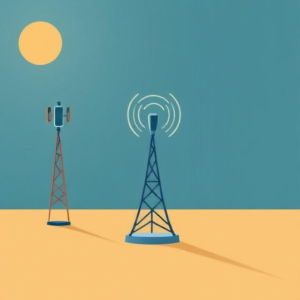What is Time-Division Multiplexing (TDM)?
Time-Division Multiplexing (TDM) is a method used to send multiple signals or data streams over a single communication channel, such as a wire or radio frequency, by dividing the available time into small slots. Each signal gets its own “time slot” to transmit its data, and these time slots are interleaved (meaning they happen one after the other, very quickly).
In simpler terms: TDM allows several signals to share the same communication path, but each one gets its turn to send data during a specific period of time.

Why Use TDM?
The main reason for using TDM is to maximize the use of a single communication channel. Without TDM, each signal would need its own separate channel, which could be inefficient and costly, especially when the signals don’t need to be transmitted all the time.
How Does Time-Division Multiplexing Work?
Let’s think about TDM as a shared schedule for sending data, where each signal takes its turn during a specific time slot.
- Multiple Signals (Channels):
Imagine you have 4 signals (let’s call them A, B, C, and D) that need to be sent over the same communication line (for example, a single phone line, fiber optic cable, or radio frequency). - Time is Divided into Slots:
The total time available for sending data is divided into equal time slots. Each signal (A, B, C, or D) is assigned one of these time slots in a repeating cycle. - Each Signal Sends Its Data During Its Slot:
- In the first time slot, Signal A sends its data.
- In the second time slot, Signal B sends its data.
- In the third time slot, Signal C sends its data.
- In the fourth time slot, Signal D sends its data.
- Repeating the Cycle:
After all signals have sent their data in their time slots, the process starts over, with each signal getting its turn again. This happens very quickly, so it feels like all the signals are being sent at the same time (even though they are actually sent one after the other).
Example of TDM:
Imagine you are having a conversation with your friends. There are 4 people in the conversation, and everyone has to take turns talking.
- Time Slot 1: Person A talks.
- Time Slot 2: Person B talks.
- Time Slot 3: Person C talks.
- Time Slot 4: Person D talks.
Once Person D finishes, the cycle repeats from Person A. Everyone gets a chance to speak in order, but the conversation flows smoothly as each person’s time is carefully scheduled.
In TDM, this process happens in a similar way, except the “talking” is replaced with data being sent. The time slots are the key to dividing the time among all the signals.
Types of TDM:
There are two main types of Time-Division Multiplexing:
- Synchronous TDM (STDM):
- In Synchronous TDM, each time slot is pre-assigned to a specific signal, even if that signal doesn’t have any data to send. This means that each signal gets the same amount of time in a fixed order.
- Example: Imagine you have 5 slots, and there are 3 signals. Even though there are fewer signals than slots, each signal is assigned its own slot, and some slots will be empty (unused) when a signal has no data to send.
- Statistical TDM (STDM):
- In Statistical TDM, the time slots are assigned dynamically based on which signals have data to send. This means that unused slots aren’t wasted, and signals that need more time to transmit can get extra slots when needed.
- Example: If Signal A has more data to send, it might get more than one time slot, while other signals that don’t need data transfer will be skipped.
Applications of Time-Division Multiplexing:
TDM is widely used in communications and networking because it makes efficient use of the available transmission medium. Some common applications include:
- Telecommunications:
- TDM is used in telephone networks, where multiple phone calls are carried over the same line. Each call is assigned a specific time slot, allowing many calls to share the same channel.
- Digital Transmission Systems:
- TDM is used in data transmission over networks, where different data streams (like internet traffic or file transfers) can share a single line.
- Satellite Communication:
- TDM allows multiple signals, such as different channels or users, to share the same satellite bandwidth. Each user gets a time slot to send or receive data.
- Radio Broadcasting:
- In radio communication, TDM can be used to combine multiple channels of audio or data onto a single frequency, with each channel getting a time slot.
Advantages of TDM:
- Efficient Use of Resources:
- By sharing a single channel, TDM reduces the need for multiple physical communication lines, saving cost and space.
- Better Bandwidth Utilization:
- TDM ensures that the available bandwidth is fully utilized by assigning specific time slots to signals, minimizing wasted space.
- Clear Separation of Signals:
- Since each signal gets its own time slot, there is minimal interference between the signals, ensuring clean and organized transmission.
Disadvantages of TDM:
- Fixed Time Slots:
- In Synchronous TDM, fixed time slots can lead to inefficiency if some signals don’t have data to send. Some time slots may go unused, leading to wasted bandwidth.
- Latency:
- There can be a small delay between when a signal is ready to be sent and when its time slot comes up, which can add some latency (delay) in the system.
- Complexity:
- Managing the time slots and synchronizing multiple signals can make TDM systems a bit more complex to design and maintain.
Summary:
- Time-Division Multiplexing (TDM) is a method of transmitting multiple signals over a single channel by dividing time into small slots and assigning each signal its own slot.
- TDM works by interleaving the signals, meaning each signal takes turns sending data at regular intervals.
- There are two types: Synchronous TDM, where time slots are fixed, and Statistical TDM, where time slots are assigned dynamically.
- TDM is used in telecommunications, data networks, and satellite communication, among other areas, to efficiently use available bandwidth.











